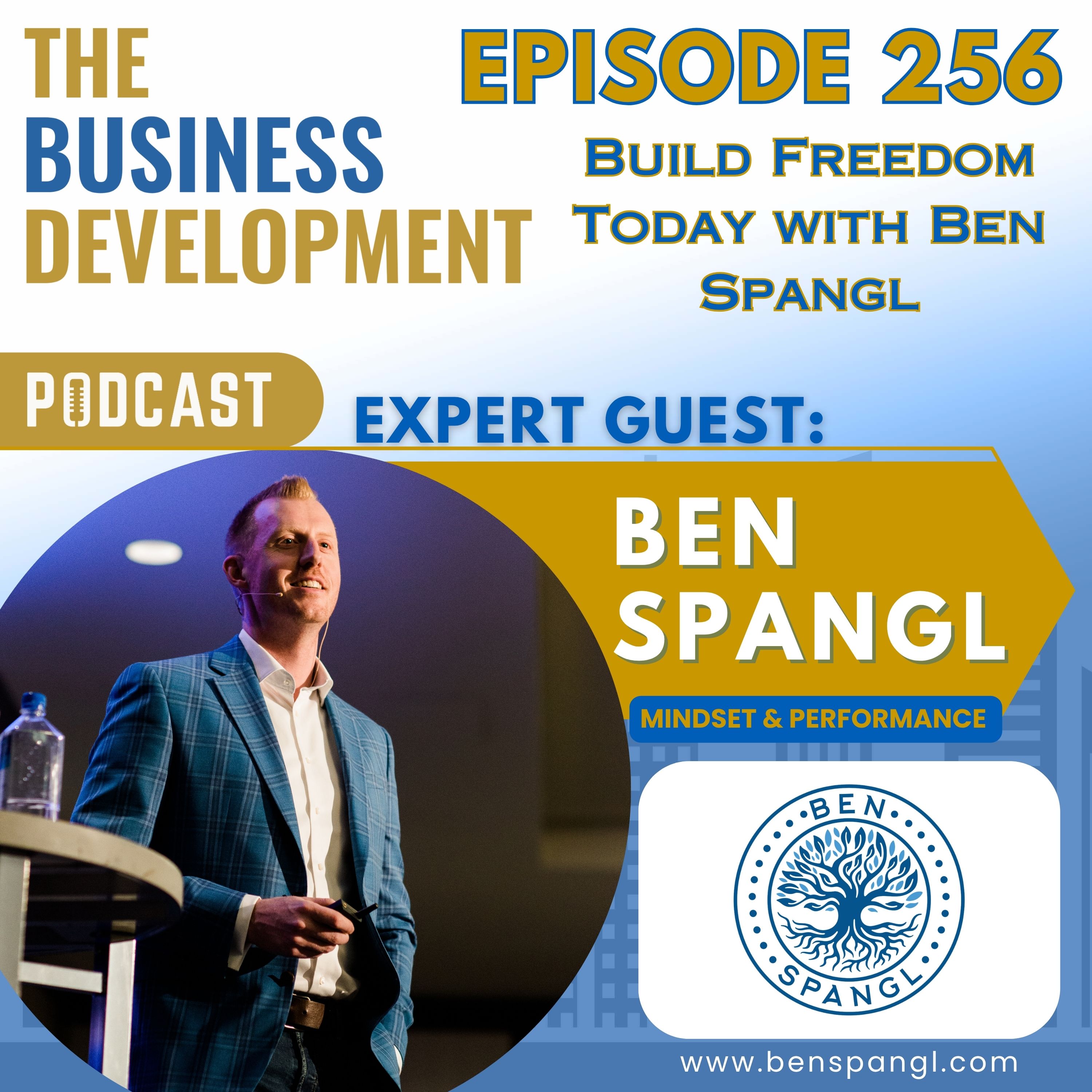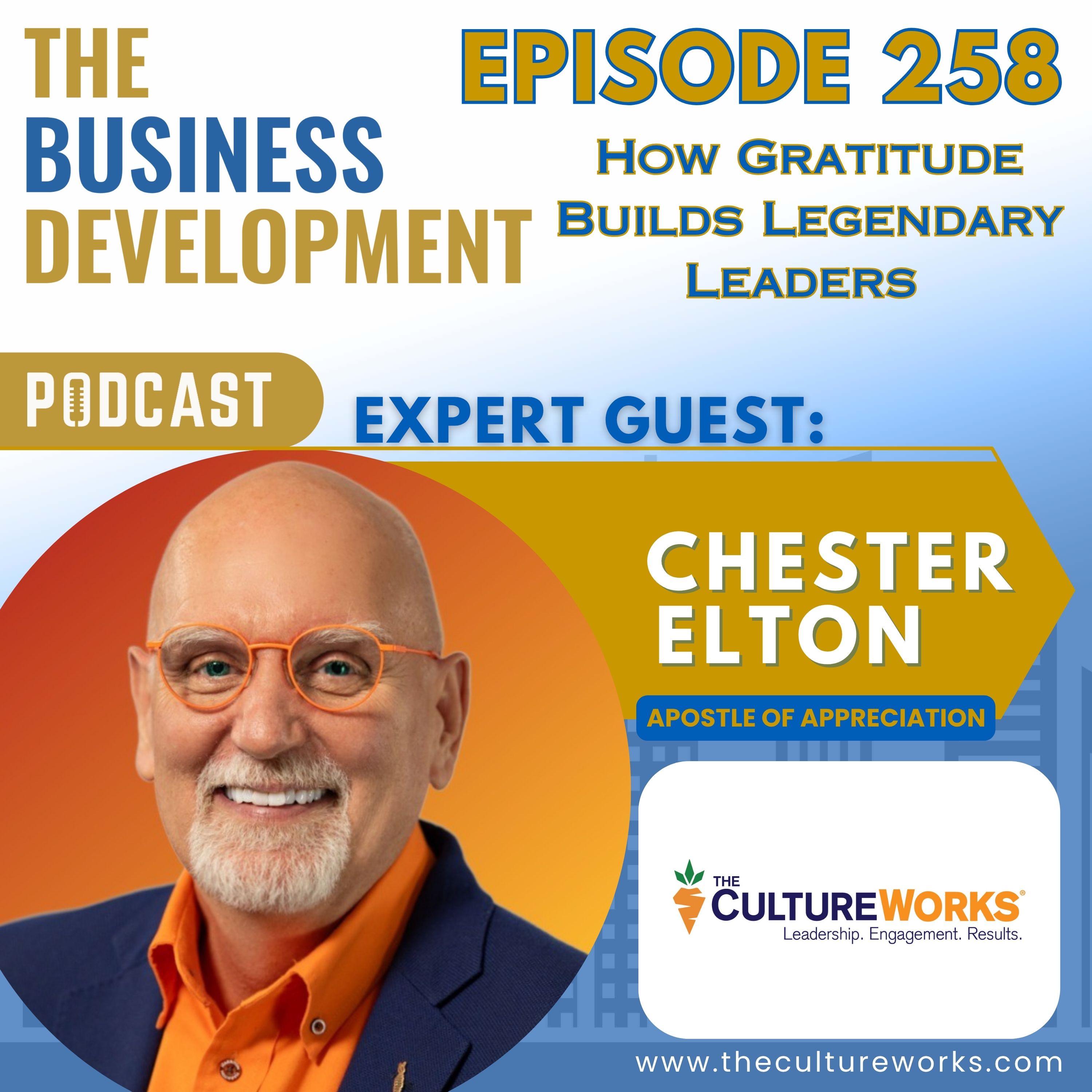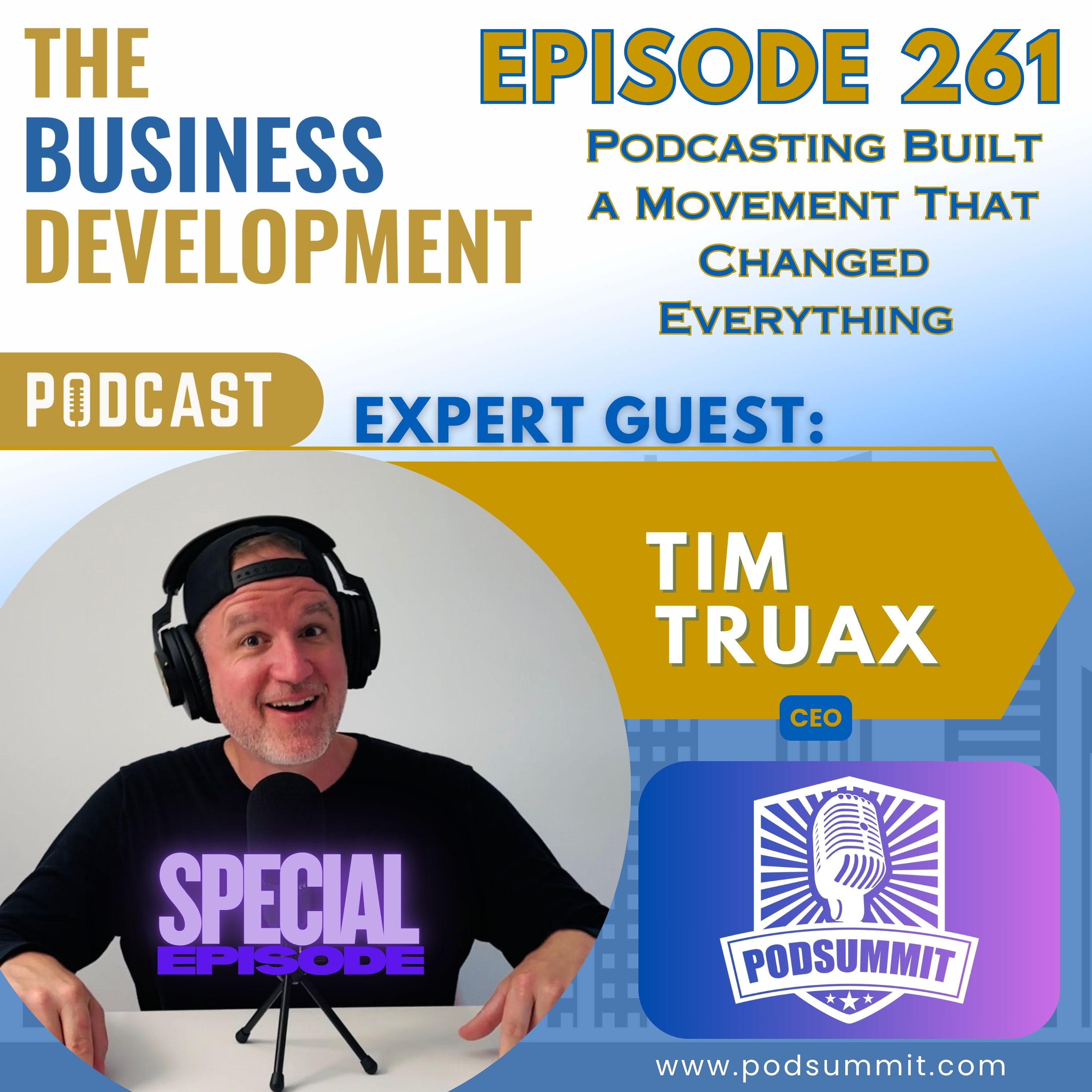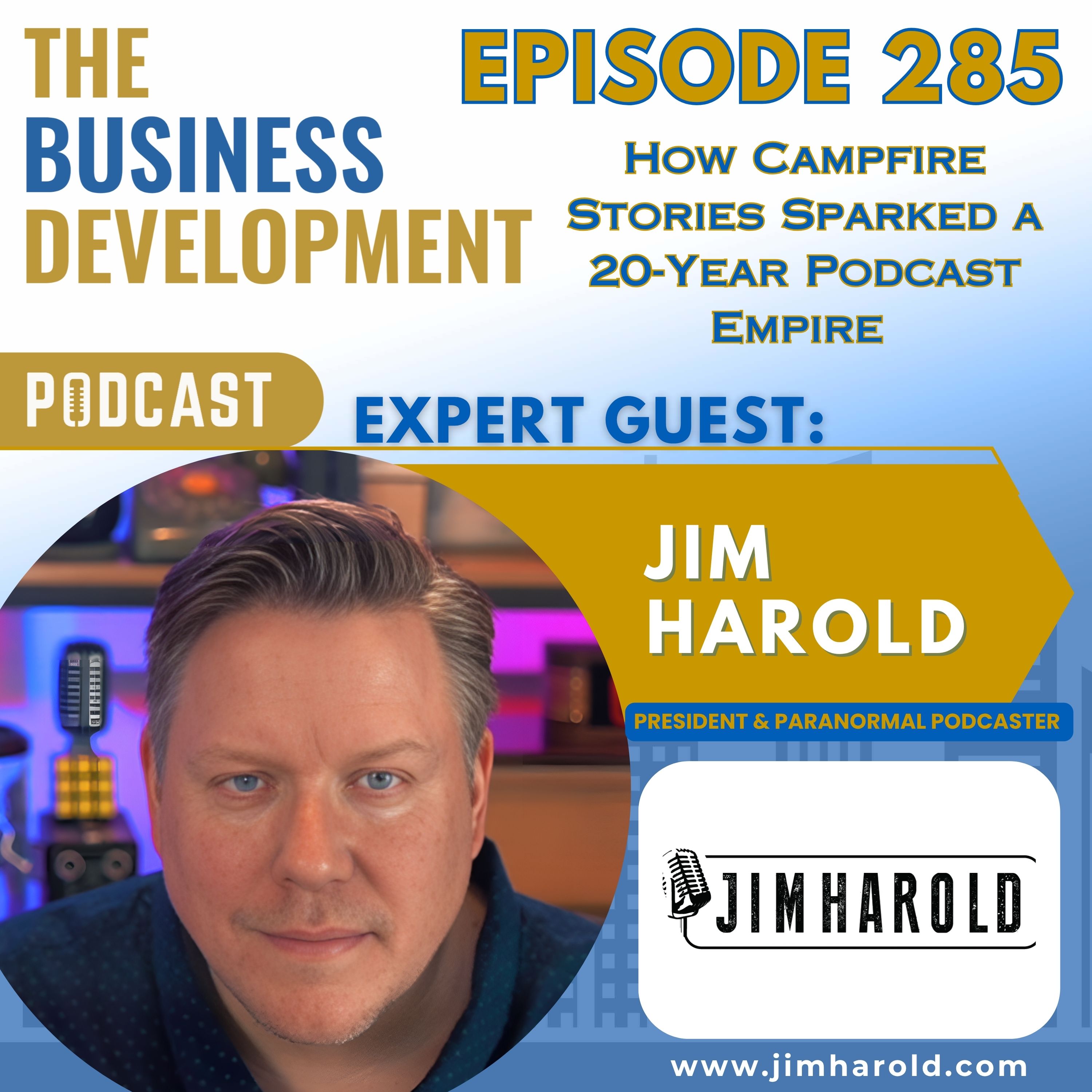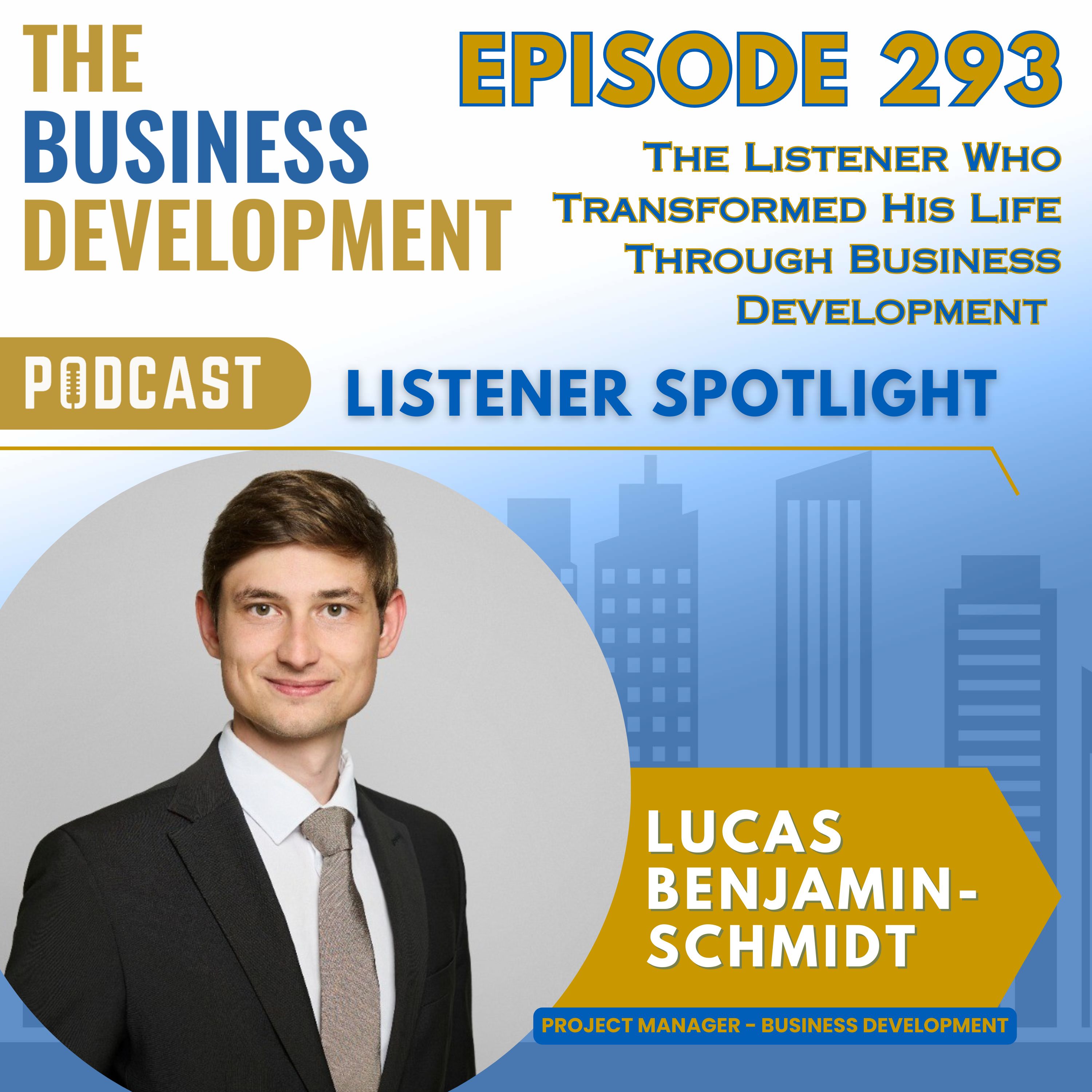Podcast Playbook (Part 7): How to Edit Your Podcast Like a Pro — My Full Workflow for Clean, Studio-Quality Sound
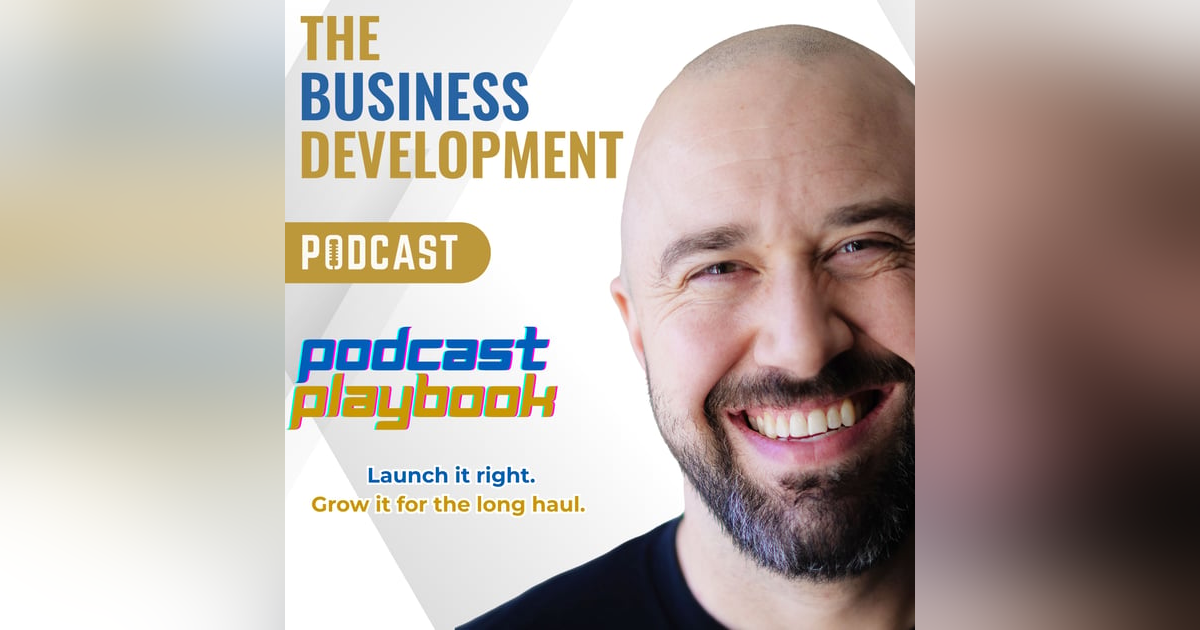
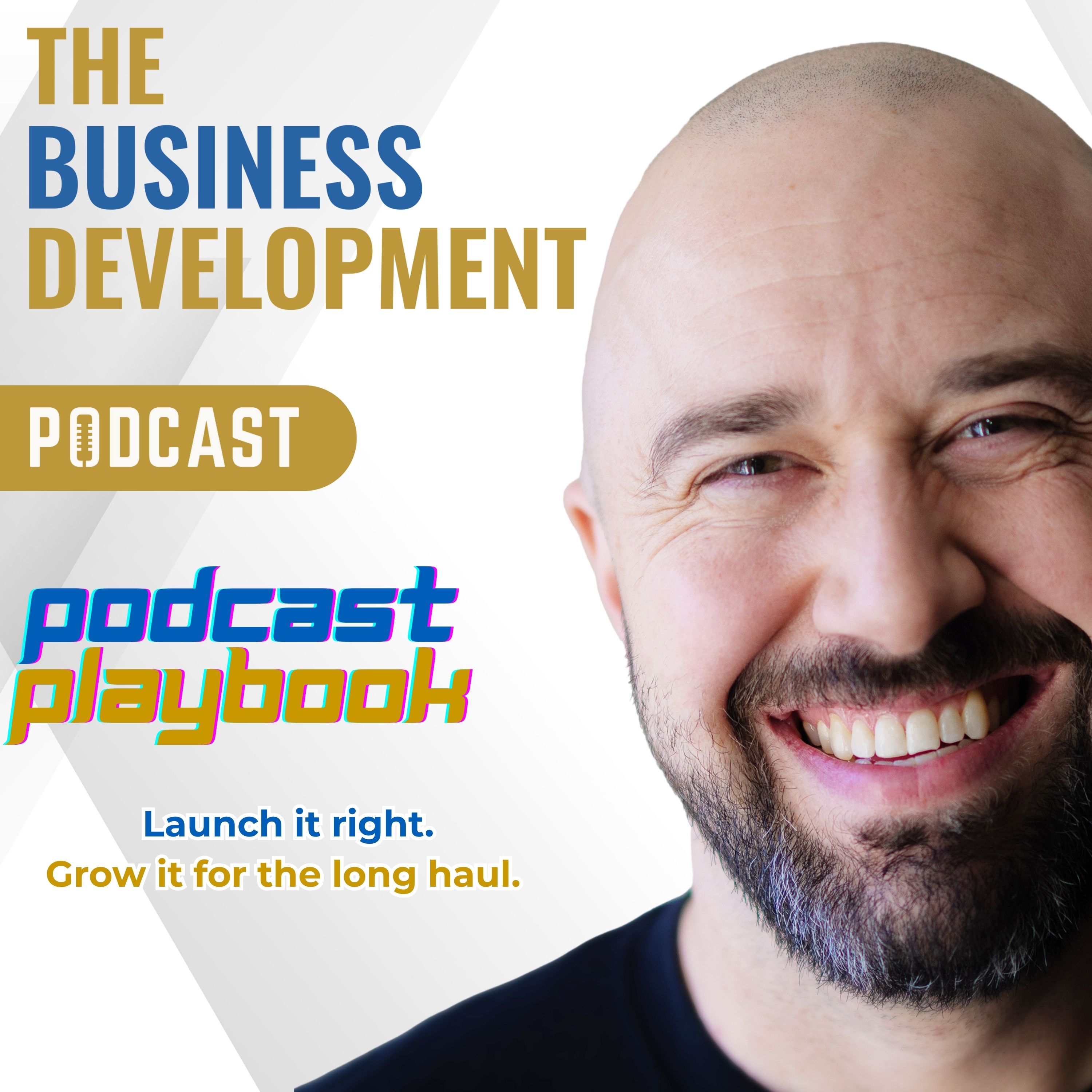
Episode 263 of The Business Development Podcast takes you deep into the editing stage of podcast production, where a raw recording transforms into a polished, professional show. In Part 7 of the Podcast Playbook series, Kelly Kennedy shares his complete start-to-finish editing workflow, honed over hundreds of episodes. From understanding your DAW workspace to identifying and fixing common audio problems, he covers the why and how behind every step, always keeping the listener’s experience front and center. Kelly also breaks down his go-to plugins, explains their real-world use cases, and offers detailed guidance on creating a consistent, clean sound that keeps audiences engaged.
Listeners will walk away with a clear, repeatable process for editing like a pro, including the exact sequence Kelly uses to repair, enhance, and master audio before releasing it into the world. Alongside the technical instruction, he shares valuable mindset advice—normalizing the learning curve, encouraging practice, and reminding creators that great editing isn’t about chasing perfection, but about respecting your audience’s time and attention. Whether you’re a beginner or a seasoned podcaster looking to tighten your process, this episode delivers the tools, techniques, and confidence to elevate your show’s production quality.
Key Takeaways:
1. Editing is for the listener, not you, and should focus on making the show easy and enjoyable to follow.
2. Understanding your DAW workspace is essential before making any edits.
3. Common audio issues like hiss, hum, reverb, plosives, sibilance, clicks, and uneven levels must be identified and fixed early.
4. Use the right plugins to solve problems efficiently without overprocessing the voice.
5. Always fix issues before enhancing audio with EQ, compression, or clarity tools.
6. Edit for your ears, not your eyes, and trust what you hear over what you see on the waveform.
7. Keep a human feel by leaving natural pauses and personality in the conversation.
8. Maintain consistent loudness levels to meet podcast industry standards and avoid listener volume adjustments.
9. Record and use room tone to make cuts seamless and keep edits invisible.
10. Perform a full quality control listen-through on multiple devices before publishing.
Podcast Playbook (Part 7): How to Edit Your Podcast Like a Pro — My Full Workflow for Clean, Studio-Quality Sound
Kelly Kennedy: Welcome to part seven of Podcast Playbook. Today we're tackling one of the most important and most overlooked skills in podcasting, the edit. This is where raw conversation transforms into a show that people actually want to hear. I'm gonna take you inside my exact editing process, the same workflow I've used to make hundreds of episodes sound clean, professional, and ready for a global audience.
Whether your recording was crystal clear or a complete mess, by the end of this episode, you'll know exactly how to shape it into something your listeners will love. Stick with us. You don't wanna miss this episode.
Intro: The Great Mark Cuban once said, business happens over years and years. Value is measured in the total upside of a business relationship, not by how much you squeezed out in any one deal.
And we couldn't agree more. This is the Business Development podcast based in Edmonton, Alberta, Canada. In broadcasting to the world, you'll get expert business development advice, tips, and experiences, and you'll hear interviews with business owners, CEOs. And business development reps. You'll get actionable advice on how to grow business, brought to you by Capital Business Development Capital BD ca.
Let's do it. Welcome to the The Business Development Podcast, and now your expert host. Kelly Kennedy.
Kelly Kennedy: Hello. Welcome to episode 263 of the Business Development Podcast. What a week it has been. It has been a full week with my new baby boy, Foxxx Kennedy.
He was born last Wednesday, August. Sixth. He is healthy, he is happy. Shelby is healthy, Shelby is happy. And wow. It has just been a bit of a whirlwind, guys over the past week, but thank you. Thank you. Thank you so much for bearing with us. I hope that you enjoyed our incredible episode. With the CEO of PodSummit, Tim Truax, it was amazing having him on to chat about it.
It was just a perfect fit, honestly, a perfect fit for the middle of our podcast playbook series, and I think just a really good lead in to today's show. Thank you Tim, for doing that. It was just a perfect fit here for the podcast playbook series, and great to have PodSummit right in the middle of it, encouraging podcasters everywhere to pick up that mic.
That's the whole point of this guys. That is the whole point of podcast playbook series. I wanted to share everything that I knew about podcasting to help thousands of people over time start their own shows. I know there's lots of podcast information out there on the internet, but I wanted to hopefully lay it out in a way that was easy to understand, that was easy and step by step to follow.
That was free. That gave you a. Free option to do it instead of you having to pay for some course or anything like that. I wanted to just give you guys something that you could follow, and I hope that we have done that. The feedback so far has been incredible, and I just wanted to thank each and every one of you for joining me on this journey.
It's just been an absolute crazy week, and I do just want to take one moment here to acknowledge my fiance, Shelby. For the amazing job that she did, bringing little Foxx into the world, guys, it truly is a privilege to be there for such an incredible life changing event. For me, it was my second time and she did just such an amazing job and I love you so much, babe.
Thank you for all you do to make this show possible, to keep our family going. These nights, especially Podcast Playbook. Guys have been running super, super late. This has not been an easy series for me. This specific episode is gonna be one of the harder ones just. Trying to talk technical on how do you edit a podcast is not an easy task.
Guys, it has taken me a long time. A lot of planning, a lot of laying it out, making sure that I have it right. This is gonna be a very technical episode. However, for the people who care about editing. This is going to be a powerful episode, and if you do the things we talk about today, it will separate your show.
No question. It will make your show sound so much better. I can't even tell you the difference it makes to go from an unedited show to a final polished show. It's like night and day. It's like night and day. And guys, with the tools available to you now with good computers, with plugins. With Daws like Adobe Audition, there's no reason that you can't have a show That sounds incredible like it was made in a studio because it pretty much is.
It pretty much is by the time we go through the steps we're gonna talk about today. I wanna make sure that each and every one of you who chooses to start a show, gets a show That sounds just as good as like anything else that you can hear in Podcast Land. Okay? That is the goal of today's episode, so please bear with me.
It is going to be probably the hardest episode of the podcast Playbook series. Don't be afraid to pull out a notebook. Don't be afraid to take notes. Don't be afraid to listen to this like six times. You might need to. It's completely okay. Podcast editing has been like the bane of my existence since learning podcasting, however.
Every single year, I get better every single year. And I just wanna like preface this show by letting you know that it is okay If your first few episodes come out crappy. If your first a hundred episodes come out not to par, that's fine. Okay. Like right there with you. Okay. It has taken me hundreds of episodes of the Business Development Podcast to get the sound you're hearing today.
Okay. It is a learning experience. There's almost nothing that anyone can tell you that will just make you a pro at this overnight. It really is a a learned skill. Okay. What I'm gonna try to teach you guys today is what to look for and what tools and tips can I give you to help you get through that process faster.
Even if I can help you guys get through the process 50% faster than I did, it's gonna put you a hundred percent ahead of the amount of time it took me to get my sound to where it is today. So if we can get your sound great in the first, let's call it a hundred episodes. The sky's the limit, guys.
The sky is the limit for you past that point. Okay, so today we are on part seven of Podcast Playbook. Yeah. Funny story with this one, guys. I've sat down to write this particular episode three times. If you can't tell, it's the one that I've struggled with the most. This episode is really the reason that it's taken me so long to do podcast playbook series, period, and that is completely true.
Audio editing. Such an important skill in podcasting guys. It really is a good edit. Guys will make all the difference, a massive difference in the sound and listen ability of your show. And if we can get the sound and listen ability of your show, good, more people will follow your show and get a ton of value from it.
Audio editing is also a skill, like I said before, that takes practice and repetition. It's gonna take you a while. You're not gonna become a pro editor overnight, definitely not from listening to this or reading anything. You must practice. So caveat, you must, must, must practice audio editing over and over and over again.
This episode is simply to help you understand how I edit. Once again, how I do it, what the terminology is and what it all means. And once you can understand what that is, that was a big struggle for me in the beginning. 'cause I just didn't know what anything was. Once I understood it, I could hear it and once I could hear it, I could fix it.
But you have to be able to know what you're looking for and you have to be able to get the ear for what it is you are hearing before you can implement the fixes. Today's show will help you be able to know what you're hearing. And get that perfect sound for you time after time. Editing is the place where your podcast becomes the show.
You always imagine this is true when you listen to shows. When you said, I'm gonna start a podcast, it was because you have a podcast you love, almost guaranteed, and you wanted to get that sound. Audio editing is where you get it. It's where mistakes vanish. It's where flow improves and your voice becomes clear, crisp, and enjoyable to listen to.
For this part of the playbook, guys, I'm going to walk you through my personal process, okay? I do my main edit on Adobe Audition. I've said this multiple times throughout the series so far. And then I actually do a final finish cleanup. The final pass you may say on Descript. These are absolutely my tools of choice because together they give me the precision of a full audio edit through audition.
And the editorial polish of transcript based editing in Descript gives me that like final cleanup where I can remove those filler words and get the sound just right. If you decide to fully edit your show, and I encourage you all to try, I highly recommend using both Audition or an editing DAW and Descript.
That combination gives you the best of both worlds, but even if you are using something different, completely fine. Audacity, GarageBand, Reaper, Hindenberg, journalist, whatever, most of what I'm teaching you here will transfer across any dot. The controls may be in different places, but the workflow, the way you listen and the decisions you make as an editor are exactly the same.
Once you have the ear for guys, you can edit on just about anything. So now that you know the tools that I use and why this process will work for you, no matter the draw you're in, let's start with the big question. Why do we edit? Why edit at all? Why not just record and post? Okay, fair. Let's talk about it.
Here's the truth. Editing is not just about making your show sound. It's about creating the kind of listening experience that keeps people coming back. Okay. Editing is not just about the sound of your voice, it's about the clarity of the message as well, and making sure that you have a great listening experience.
We edit for a few critical reasons and they all come back to one thing, the listener. Everything we're doing here guys, is for the listener. It's not for you. You know what you sound like. You know what you said. It's how do we make this show the best possible show we can for the millions of people over time who will hear it.
We edit to remove distractions, the ums, the ahs, the awkward pauses, the barking dog in the background, the firetruck, whatever, the airplane. We gotta get rid of that. Anything that pulls attention from your message has to go. We edit to improve flow, tightening the conversation, trimming tangents, and making sure that ideas connect in a way that is easy to follow.
We edit to balance levels. Okay, this is a big one, and I struggled with this immensely in the beginning. No more moments where you have to crank the volume to hear your guest and then get blasted by your own voice in the next sentence. We have to level the volume. Everyone has to sound the same level of loud.
Okay? We edit to fix technical issues. Hiss hum, echo, explosives, mouth clicks. All the little annoyances that will make a listener turn off your episode within minutes. And guys, this is like the biggest killer of shows. Okay? If the sound is bad on the audio, it doesn't matter what the message is, the people won't listen.
Okay? We have to get the podcast to at least a level of acceptability by somebody's ears to give it. The time to give you the time it takes to listen to your show. Okay? We have to get the audio right. Otherwise, the message doesn't matter. We edit to add branding, your intro, outro, music and transitions.
Give your show a professional identity and make it instantly recognizable. You guys could tell my show from the intros and outros anywhere. We gotta do that. We gotta get that for you too, and we edit to respect time. Okay? You're a busy professional, so am I. Okay. If we can deliver the same value in a tighter, smoother episode.
We're showing that not only are we great editors, but we value our listeners' attention and time. This is not about chasing perfection, although we all do it a little bit. It's about making your show as easy and enjoyable to listen to as possible, because if your audience. Has to work to enjoy your podcast.
They will find one where they don't have to work before you ever hit publish. Guys, before you ever hit publish, ask yourself these questions from the listener's perspective. Number one, can I focus on the content without being distracted? No constant hiss hum, or background noise, pulling your attention away.
Number two, is the flow easy to follow? No rambling tangents, dead air, or sections that feel like they go in circles. Number three, do I ever have to adjust? The volume levels are consistent from start to finish for all voices and sounds okay. We have to make sure that we have consistent sound across our voice, guest voices and music.
Four, does every minute earn its place? Nothing feels like filler. Every section delivers value, entertainment, or connection. Number five, does it sound comfortable for long listening sessions? No piercing S sounds, boomy pops, or harsh tones that can cause listener fatigue. Number six. Does the episode sound like a show or just a recording?
Intro. Outro and any music or transitions must feel intentional and professional. Number seven, would I recommend this episode if I was a listener? This is key, guys. If the answer is yes, you've done your job every single. Show has to meet these criteria. So now you understand why we edit. It's not just about sounding good, it's about making the show easy, enjoyable, and worth your listeners time.
But before we can start fixing problems or improving flow, you need to get comfortable with your workspace, your daw, DAW, because whether you're in Adobe Audition like me or Audacity, GarageBand, Reaper. This is the environment where all the polishing happens. Let's break down what you are looking at, how audio is represented visually, and how to start feeling confident moving around inside your editing software.
Next, we have to understand. Workspace before we start cutting, cleaning, or polishing, you need to know your editing space. Your DAW stands for Digital Audio Workstation. It's a fancy way of saying the software where you edit your podcast or music, if that's what you do. Think of it like your workshop.
The tools are in different spots depending on what DAW you're using. Adobe Audition, audacity, GarageBand, Reaper, Hindenberg, Descript. And guys, there are way, way more than that. Those are just the big ones. But the fundamentals are always the same. Number one tracks when you open a project, you will usually see multiple horizontal rows.
They are called tracks. Each track is like its own lane in the highway. You might put your voice in one lane, your guest's voice in another, and your music or sound effects in their own separate lanes. Keeping things separated makes it easier to control and edit them individually without messing up the rest of your episode.
The cool thing about these tracks, guys, is that like whatever you apply to them only applies to that track. So your voice might sound great, but your guest's voice might be like echoey or like. Way different or quiet. The cool thing about these individual tracks is you can change them without changing all of the tracks at once.
So you can really fix individual challenges. Number two, the wave form your audio's shape. Every sound you record is shown as a squiggly line called a waveform. This is how your DAW visually represents volume and energy. The taller the waveform, the louder the sound at that moment. The shorter the waveform, the quieter the sound.
A completely flat line usually means silence or very close to it. Here is the magic. Once you start editing, you will be able to see problems before you even hear them. A tall spike might be a pop from a P sound, A random little bump in silence could be a mouth click. A thin fuzzy line across a quiet section might be a background hiss. over time you'll be able to visually see problems. Number three, the timeline. Your DAW lays out everything from left to right. That's called your timeline. The start of your episode is on the left and the end is on the right. The numbers above the tracks are either seconds or minutes. You can scroll and zoom in to get closer to a specific section like moving a magnifying glass along a map.
Zooming in lets you make surgical edits. Zooming out lets you see the big picture and flow. Number four, the transport controls. These are the basic buttons you will use over and over again. Play, stop, pause, record loop. They are usually at the bottom or the top of the screen depending on your software.
Learn those first. They are your steering wheel and brakes. Number five, your editing tools. Every DAW has different icons, but they all give you similar powers. Number one, the selection tool. Click and highlight sections of audio. Number two, your razor or split tool. You can cut audio into separate pieces.
Number three, your move tool. You can drag clips around. Number four, your fade tool. Blend one clip into another so it sounds smooth. Once you know how to read a waveform, navigate your timeline and use basic tools. You are in control of your editing environment. You're not guessing anymore. You can look at your screen and actually understand what is happening in your audio.
And once this happens, guys, you can edit. Now let's talk about the problems you're going to find in your audio, and more importantly, how we fix them. When I'm editing my own show, these are the things that I'm always listening for. And honestly, after you've done a few episodes, you'll start hearing them everywhere, even in other people's podcasts, and that's when you know that your ear is getting sharper.
Number one background hiss, it sounds like a constant sh I notice it most when I take my headphones off after a session and realize that the room is actually quieter than the track. The fix is using a tool like RX voice, DNO light, DNO reduction, or just record with a lower gain in a quieter space. Number two, hum or electrical buzz.
I've learned to spot this just by looking at the waveform. It leaves a faint, steady band at the low end. You can fix it using RXD hum. Use balanced XLR cables and keep audio and power cables separated. Number three, room echo anDe-reverb. I can tell right away when a guest is recording in a kitchen or a big open room, it has that hollow distant tone.
You can fix it using a tool like acon DeVerberate three, which is exceptional. Use Rx de-reverb lightly and use better recording spaces where possible. It has never been easier to fix reverb guys, but we do have to be very careful with it and it is still best if we can reduce it ahead of the recording.
Number four, plosives A strong P or B can jump out even if the rest of the track is perfect. I always check the first few minutes of an episode for them. There are a few different fixes you can use a high pass filter, you can reduce the gain or use a pop filter or tilt the mic off. Center number five.
Harsh S sounds. Sibilance is one of those things that gets more annoying the longer you work on the track. I try to deal with it early so I don't tune it out. You can fix it using a De-esser at six to eight kilohertz, or you can use an EQ cut at the sibilance sound or fix it using different mic placement.
Number six, mouth clicks and smacks. I hear these most often in solo recordings or long monologues. Once you notice them, you can't stop hearing them. You can fix them using a De-click like RxDe-click mouth mode, or cut and fade them, or just stay hydrated and try to reduce them in the first place. Number seven, uneven volume levels.
This is usually just natural conversation, but it can feel amateur. If you don't even it out, you can fix it using compression clip gain or your leveler in Descript. Number eight, long pauses or rambling. I've cut my own pauses plenty of times like. Sometimes what feels dramatic in the moment can feel slow in playback, cut pauses with cross fades, trim tangents, or prep better before you're recording.
The faster you can recognize these issues, the faster your editing will be and the more natural the finished episode will sound. You now know the problems you'll hear in raw audio and the basic ways to fix them, but here's the reality. Manual fixes will only get you so far for speed, consistency, and top tier results.
You'll need the right plugins. These aren't just extra effects. There are precision tools designed to solve specific problems better and faster than anything built into your daw. What a plugin really is? Your DAW is like a basic tool chest. It has hammers, screwdrivers, maybe a saw you can build with it, but when you need to drill a perfectly straight hole or surface to a flawless finish, you'll pull out the specialty tools, and that's exactly what plugins are.
Purpose built solutions for audio problems that would otherwise eat hours of your life. The five plugins that I rely on every single week are as follows, number one, Izotope RX 10 and 11 suite, the audio repair powerhouse, why it matters most. Daws can reduce noise or EQ of voice, but RX lets you surgically remove problems without touching the good parts of the audio.
The core modules that I use are voice de-noise in adaptive mode with two to six decibels reduction. It smooths hiss without dulling the voice. I then use De-click in mouth mode with sensitivity three to five, perfect for saliva, clicks, and lip smacks. Then I use De-reverb, which pulls back room echo, but I use it very lightly to avoid metallic artifacts.
And then I use spectral repair, which lets me paint out unwanted noise like coughs or keyboard taps without cutting the conversation. Fix problems here first. So the rest of your mix is working from a clean slate. Number two, I use Supertone Clear, AI Clarity Boost. Why does it matter? Even a clean recording can sound flat or distant.
Super tone clear uses AI to pull the voice forward so it feels immediate and engaging. How do I use it? I add just enough to make the voice feel like it's in the room, and then I back it off slightly so it still stays natural pitfall to avoid overuse can make a voice sound artificially bright subtlety.
Key number three is ACON Digital's DeVerberate three, transparent Echo Control. Why does it matter? Reverb Rob's speech of intimacy most built-in De-reverbs work, but they leave artifacts. Acon transparency means that I can fix echo without making it obvious. How do I use it? I start at 20% reduction and then inch it up as needed.
Keeping a touch of room tone so it doesn't feel dead. Decision point, if echo is minor, I may skip this entirely Too much processing can be worse than leaving it alone. Always air on. Less is more. Number four, the Sonible Smart Series plugins for intelligent processing. Why does it matter? Compression and EQ are essential for voice, but manually dialing them in can take time.
Sonible smart plugins. Learn the track and adapt automatically. This is like fully AI guys. Key tools I use is the smart compression, which targets peaks and valleys, keeping the voice consistent without killing dynamics. And I use the smart EQ, which fixes tonal imbalances, and it's especially handy when different mics or rooms are used.
Pro tip, let the plugin make the first pass, and then makes subtle changes by ear. Last but not least, number five Accentize Dx Revive Pro, the Remote Audio Rescuer. This is like a brand new tool for me guys, and it is incredible. Why does it matter? Not all guests have great gear or quiet rooms, most of them.
This is my save the interview button for rough remote recording. How do I use it? Light touch at first guys. Sometimes like 30% is more than enough to dramatically improve clarity. When would I skip it? If the audio source is already clean, I leave it untouched to avoid overprocessing. This particular one, guys, if you tune it up too high, it can really be hard to listen to.
Like I said, overprocessing is hard on the ears. Less is way more with Accentize DX Revive Pro. However, if you have bad audio or like the recordings outside or you're dealing with like something that you think might be unusable, this thing can probably fix it. The golden rule with plugins is this, plugins are not magic.
They are tools. Use them only when they're needed and always serve the voice, not the software. Next, let's move into the full edit workflow from Raw Audio to Final Master. This is where everything happens in sequence. I'm not bouncing between programs or re-export endlessly. It's one pass from the import to the final MP3, with every step serving the next step one, import and organize. In Adobe Audition, the first thing I do is get my workspace clean and logical. Every voice track gets its own lane labeled clearly, Kelly host, guest one, guest two, et cetera. The music beds and sound effects sit in their own tracks so I can control their volume independently.
I trim the very start and the end, so I'm not starting at 30 seconds of silence, but I keep a natural pause that helps the conversation breathe. Step two, clean up and repair plugins from section four. Here's where the problems vanish. I fix noise, clicks, and echo. Before I touch tone or dynamics. I run supertone clear last in the chain so that the final brightness sits on top of a clean foundation.
If a guest mic was bad. I'll patch it with DX Revive Pro before we move forward. Step three, cutting and Blending. This is about story flow, not just removing ums. I'll cut tangents that drag false starts or sections where somebody completely loses their train of thought. I'll use short cross fades, 10 to 20 milliseconds at every cut to make them invisible to the ear.
If I remove something in the middle of a sentence, I blend in matching room tone so it sounds untouched. Step four, loudness and mastering. Now we make it ready for the real world. I target -16 LUFFS stereo or -19 LUFFS mono, which is the industry standard for podcasts. I add a light bit of compression, just enough to glue the mix without killing dynamics.
I check peaks to make sure that nothing goes over minus three decibels. Avoiding distortion on streaming platforms. Step five, I export and do a descrip pass. I export a 24 bit wave master out of audition. I drop that into descrip for my polish pass, scanning the transcript to cut stray filler, awkward pauses or things that I missed visually in the waveform.
And guys, I always miss something in the waveform. This is the best way to get the best possible final product. I then export that final MP3 at 256 kilobytes per second. Tagging it with the correct metadata and cover art. Even the most dialed in workflow can miss things if you don't listen like a listener.
My QC pass is always the same. I listen, start to finish without touching a control if something bothers me here. It'll bother my audience. I check it on headphones and speakers because each reveals different flaws. I make sure that ad spots fade in and out naturally to match the episode's loudness, and I confirm that the metadata and file names are exactly how they should appear on my hosting platform.
When this is done, I know that the episode is ready to go live without any, I should have caught that moments, and guys, I have had so many, I should have caught that moments. That's why the listen through, the full edit on audition, and then the last pass through on Descript to catch. It gives you two full opportunities to catch your errors, and it does allow you to have nearly a perfect show every time.
Here are some key lessons for a great edit. Number one, fix the problems before you enhance. Think of editing, like home renovation. You wouldn't paint a wall before patching the cracks. The same goes for audio. If there's a background hum, clicks, explosives, reverb, those flaws are only gonna get worse once you start EQing it or compressing it.
Run your noise reduction D, click and de reverb tools first. This gives you a clean foundation that every future enhancement can build on. Number two, edit for your ear, not the eye. Your jaw will tempt you to stare at the waveform like it's a visual puzzle to solve. But remember, your listeners will never see this waveform.
They will only hear the result. If something sounds wrong, but looks fine, trust your ears every time. That's how you avoid over editing based on what looks right, but actually kills the feel of the conversation. Number three, keep a human feel. Yes, you can remove every ah, and pause. But should you often, those imperfections make the speaker relatable and authentic over editing can strip away the personality and make your show feel stiff.
Instead, focus on removing true distractions, repeated words. Filler tangents, long silences, and leave enough breathing room for your audience to connect with the voice. Number four, protect the voice. The human voice is incredibly dynamic. Small changes can make it sound silky, smooth, or robotic and brittle.
Avoid stacking heavy processing unless it's necessary. Use EQ to shape rather than completely reinvent the voice. Keep compression light and natural. And don't let noise reduction create artifacts that make speech sound watery. Your audience should feel like the guest is in the room with them. Number five, use room tone.
Like glue. Every space has a signature silence, the faint background sound that exists even when no one's talking. When you cut out parts of speech, you can create unnatural dead silence or mismatch noise floors that draw attention. Record a few seconds of room tone at the start of each session and use it to fill gaps.
It's one of the simplest tricks to make your edits vanish into the background. Number six, master your Loudness Levels. Podcasts have loudness standards for a reason. They keep listeners from having to constantly adjust the volume between shows. Target minus 16 LUTs for stereo and minus 19 LUTs for Mono.
This ensures your podcast matches other professional productions on Apple Podcast, Spotify, and other platforms. It's the difference between sounding polished and sounding like a hobbyist. Number seven, qc. Like your reputation depends on it because it does. Before you release, listen all the way through.
Yes, the whole episode. Do it on headphones and again on speakers because each reveals different issues. Listen for clicks, awkward cuts, mismatch levels, or even moments where the conversation feels confusing without visual cues. This is your final safety net before the world hears your work. There you have it.
My complete start to finish editing workflow that takes raw, messy conversation and transforms it into something people actually want to listen to. This isn't about chasing perfection for perfection's sake. It's about respecting your listeners' time and delivering. An experience that keeps them coming back.
Editing is where your podcast stops being a recording and starts being a show. Master this stage and you'll separate yourself from 90% of the podcasters out there. The beauty is you don't have to get it perfect on day one. You just have to start. Learn with each episode and keep pushing your quality higher.
In the next part of Podcast Playbook, we're leaving the editing suite and heading straight to the launchpad. I'm gonna show you exactly how to get your episode uploaded, scheduled, and optimized so that it reaches the maximum number of years because the best sounding episode in the world is wasted if no one hears it.
Until then, keep recording, keep refining, and keep showing up for your audience. That's how you build something worth listening to. Until next time you've been listening to the Business Development Podcast, and I'll catch you on the flip side.
Outro: This has been the Business Development Podcast with Kelly Kennedy.
Kelly has 15 years in sales and business development experience within the Alberta oil and gas industry, and founded his own business development firm in 2020. His passion and his specialization. Is in customer relationship generation and business development. The show is brought to you by Capital Business Development, your Business Development Specialists.
For more, we invite you to the website@www.capital bd.ca. See you next time on the Business Development Podcast.










